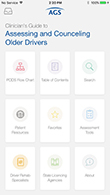Safe Driving for Older Adults

Sponsorship Type: Non-Funded
Research Type: Evaluation
Impact: National
Infographic courtesy of the Center for Disease Control and National Institute for Occupational Safety and Health.
Motor vehicle injuries persist as the leading cause of injury-related deaths among 65- to 74-year-olds and are the second leading cause (after falls) among 75- to 84-year-olds. While traffic safety programs have had partial success in reducing crash rates for all drivers, the fatality rate for drivers over age 65 has consistently remained high. Increased comorbidities and frailty associated with aging make it far more difficult to survive a crash, and the expected massive increase in the number of older adults on the road is certain to lead to increased injuries and deaths unless we can successfully intervene to prevent harm.
Dr. Alice Pomidor leads multiple initiatives to raise awareness of and provide resources to increase the safety of older adult drivers. Translating research findings and public health initiatives into practical everyday applications for patient-centered care is a constant challenge for clinicians engaged in the care of older adults. As the most mobile generation to date, baby boomers are already putting in more miles behind the wheel and expect to remain mobile in the community as they age, ideally with a driving “life expectancy” that keeps up with their lifespan. Below are the most recent results of her efforts.
 Clinician's Guide to Assessing and Counseling Older Drivers
Clinician's Guide to Assessing and Counseling Older Drivers
In order to support older adults’ access to health care, social interaction, and nutrition through independent mobility, interprofessional clinical team members need office-based tools to screen for medical and functional issues which may affect driving ability, assess the risk of driving impairment, intervene to optimize treatment and functional ability, refer appropriately for specialized care and driving rehabilitation, and provide counseling about planning for transitioning from driving if necessary. The American Geriatrics Society (AGS) entered into a cooperative agreement with the U.S. Department of Transportation’s National Highway Traffic Safety Administration (NHTSA) to update and expand the Physician’s Guide to Assessing and Counseling Older Drivers that was originally developed by the American Medical Association (AMA) under a prior cooperative agreement with NHTSA. The current title of the Guide — Clinician’s Guide to Assessing and Counseling Older Drivers, 3rd Edition — reflects the interprofessional nature of the team caring for an Older Adult Driver. Dr. Alice Pomidor, a faculty member of the Department of Geriatrics in the FSU College of Medicine, chaired the editorial board for this most recent edition. The main goal of the Guide remains helping health care practitioners prevent motor vehicle crashes and injury to older adults.
"Safe Driving" Campaign
With support from the National Highway Traffic Safety Administration (NHTSA), AGS’s Health in Aging Foundation lauched a public information campaign in April 2017 focused on helping older adults and caregivers access resources for safely navigating the open road. The campaign features a toolkit providing actionable safe driving tips, advice on how to have important conversations with older adults about driving limitations, and ways to continue being mobile and independent when personal driving is no longer a safe option.
Distributed during National Public Health Week (April 3-9) in the U.S., the toolkit’s release also coincided with World Health Day—Friday, April 7th—focusing on depression prevention, a significant concern for older adults who discontinue driving but are not aware of transportation alternatives for maintaining independence. The AGS’s safe driving campaign specifically provides information to these older adults and their caregivers to help them identify resources available to promote mobility, independence, and freedom to maintain physical and mental well-being. The Health in Aging Foundation developed these resources with help from an interprofessional team of clinicians and experts, which are based on tools created for healthcare professionals who counsel and assess older drivers, such as an online textbook/guide, webinars, and a mobile application that is in development.
AGS Safe Older Drivers App
AGS developed this app under a cooperative agreement with the U.S. Depa rtment of Transportation’s National Highway Traffic Safety Administration (NHTSA), with the goal of helping health care practitioners prevent motor vehicle crashes and injury to older adults. Health care practitioners caring for older adults are in a leading position to address and correct this public health concern at the individual patient and caregiver level. Released in June 2017, the app outlines assessment and counseling strategies from the most recent edition of the Clinician's Guide to Assessing and Counseling Older Drivers. By adopting preventive practices, clinicians can better identify older drivers at risk for crashes, help enhance their driving safety, and ease the transition to driving retirement if and when it becomes necessary.
rtment of Transportation’s National Highway Traffic Safety Administration (NHTSA), with the goal of helping health care practitioners prevent motor vehicle crashes and injury to older adults. Health care practitioners caring for older adults are in a leading position to address and correct this public health concern at the individual patient and caregiver level. Released in June 2017, the app outlines assessment and counseling strategies from the most recent edition of the Clinician's Guide to Assessing and Counseling Older Drivers. By adopting preventive practices, clinicians can better identify older drivers at risk for crashes, help enhance their driving safety, and ease the transition to driving retirement if and when it becomes necessary.
.jpg)
Dr. Alice Pomidor


